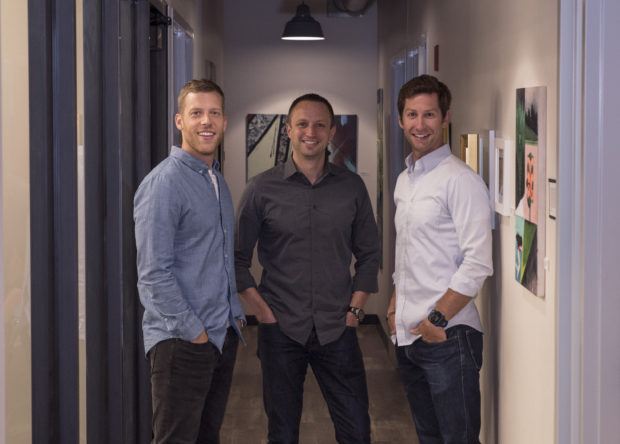“So…you’ll be CEO of a website???”
That was my parents’ confused reaction two years ago, after I spent 30 minutes walking through the rationale behind why I was going to leave the traditional insurance industry and launch Bunker. To date that was hands down my worst pitch meeting—my parents. The good news: I’m now affectionately known as “CEO of a website” to the team.
Executive Summary
Chad Nitschke, a co-founder of Bunker—the first contract-related insurance marketplace for contractors and small businesses—describes his journey from the traditional insurance industry to become “CEO of a website.” Moving past his frustration with the established industry, building an InsurTech isn’t as easy as media reports suggest. Instead, it takes dogmatic stubbornness and drive to turn a vision into reality, he writes, also describing the importance of testing prototypes with customers and learning to understand the language of investors.Rooted in Frustration
I often get asked why I started Bunker. Throughout my career, I was fortunate to work for several leading carriers in a variety of great roles. The answer to why I left is rooted in frustration. I was frustrated with the lack of change in the insurance industry. I was frustrated knowing the $5 trillion global industry should be better. I was frustrated living in San Francisco and watching startups in every other area of financial services drive innovation—banking, payments, lending—while insurance was at risk of getting left behind. I was frustrated that from inside the industry it felt like we were perpetuating more problems for customers than we were solving.
I didn’t want to be part of that anymore, and candidly I didn’t feel like I fit in. It seemed clear the better path for me would be to step outside the traditional industry, get off the sidelines and build my vision.
The Idea Is the Easy Part
Before deciding to start Bunker, I spent most of 2013 and 2014 immersing myself into the startup ecosystem, meeting with entrepreneurs, offering to help, reading blogs, listening to podcasts and even investing in startups. This served as great motivation, but more than that it provided a bit of a blueprint for approaching something I had never done.
It’s true what they say—the idea is the easy part. Being roughly two years into building Bunker, I’ll go on record to say this is a massive understatement. From the outside, press articles make it appear easy and oddly linear—you raise capital, build some tech and sell at a unicorn valuation. This couldn’t be further from the truth.

From the outside, press articles make it appear easy and oddly linear—you raise capital, build some tech and sell at a unicorn valuation. This couldn’t be further from the truth.
I’m not sure of the best analogy, but pushing a boulder uphill seems to fit. If you stop for a day, you’re lucky if the boulder stays in the same spot. More often than not, it will start rolling back downhill. Sometimes it literally rolls over you. It takes dogmatic stubbornness and drive, but that’s personally one of the things I love most about it. And now I have more admiration for anyone building something new. It’s cathartic and rewarding to work extremely hard, building something that solves a significant problem for your customers.
I knew I wanted to focus on small business insurance. It’s a massive segment of the market and significantly underserved. Customers are hungry for better solutions. The bigger question was how: How should the problem be solved? How should we go to market? How could we drive real change in a $5 trillion industry?
We still joke about the next step in the company—and by company at that point I basically mean myself, a terrible Powerpoint and a conviction to make insurance better. I knew I needed to start alpha-testing different ideas and concepts, but I needed someone to build clickable prototypes. When I asked a friend if he had any ideas, he suggested I talk to his friend Dan. I then proceeded to ramble about how I really needed to find someone “like Dan.” My friend shook his head and corrected me: “You don’t need someone like Dan; you need Dan.” That friend was Kevin Kiser, who later joined the team as Head of Client Solutions. Dan is Dan Feidt, a UX/design expert who started down the path of helping as a side project but then became convinced of the opportunity and joined as a co-founder and Head of Product Design.

Talking to Customers
Dan and I spent over six months building and iterating on prototypes. We’d brainstorm models. He’d build a prototype. Then I’d take that and demo it for any prospective customer that would talk to me. We knew we wanted to build something different. Taking the offline process and moving it online isn’t the future. I also wanted to make sure we solved for customer acquisition costs. Selling anything to small businesses is expensive, and pouring a mountain of venture funding into search engine marketing and social to acquire customers wasn’t the type of company we wanted to build—and we don’t believe that model will be sustainable over the long term.
We alpha-tested prototypes over and over until we started to learn about a feature in one of the prototypes that everyone loved. Engagement for that feature was off the charts. Over and over we heard: “I like what you’re doing—but we really love this feature. Whenever that is ready let us know because we want to start using it.”
That feature was smoothing the process when insurance was required by contract, which as it turns out drives more than 50 percent of all SMB insurance purchasing. It was invaluable feedback and gave us the conviction we needed to start writing and shipping code. It’s not uncommon for an MVP (minimum viable product) to form around a product feature vs. trying to build a boil-the-ocean solution. It’s like chess: Think far ahead but make one move at a time.
I can’t stress enough how valuable it is to build and test prototypes with customers that you expect to use your product. It is without a doubt one of the most important things we’ve done to date as a company and core to launching anything new. Not only did we end up building something we would have never discovered on our own, but it also paid significant dividends from a business development perspective. We built relationships with over 75 enterprises that represent hundreds of thousands of small businesses. They all loved what we were doing, and several of them turned out to be our first beta customers.
Translating Investor Feedback
One of the next steps in our journey was the fundraising process. We were very lucky to find great partners for both our seed round and Series A. You can change a lot about a startup, but you can’t really undo your cap table. It’s critical that you find supportive investors you really identify with as partners.
Like everything with a startup, fundraising was a learning process. It’s one thing to read never-ending blogs on the topic, but when you have your first final partner meeting, the pressure is real. I failed the first time in our seed round, and it was wrenching to go back and tell the team. I felt like I let them down. But you pick up and move on—smarter, better and tougher.
One interesting takeaway for me was how to interpret investor feedback. Although a lot of investors pass, they rarely say “no.” (A few do, and you later learn to appreciate those quick noes.) Instead, you often have to read signals. One example: When you get to the end of a meeting and an investor asks, “How can I help?”—that’s code. Translation: The meeting is over and they’re almost certainly passing.
Generally, unless an investor meeting ends with a clear next meeting being scheduled or a commitment to discuss at their next “Monday Partner Meeting,” it’s best to move on and assume it’s not the right mutual fit. Instead of spending time trying to convert noes, it’s almost always best to move on and keep driving forward.
Evolving From Building a Great Product to Building a Great Company
Now that we have money in the bank and launched a post-beta product with customers, it all comes down to execution. Execution is about hiring and building a team better than you and ensuring they’re set up for success. Internally, we refer to this part of our journey as evolving from building a great product to building a great company.
It’s an exciting time. I’m biased, but I definitely believe the insurance industry is going to look quite a bit different 10 years from now. It’s anyone’s guess what that will be, but the exciting part is that it’s up to us—founders, InsurTech employees and industry professionals—to shape what that future will be. I always tell the team, if Elon Musk can build a plan to colonize Mars, we can surely improve an industry that is made up of paper, people and promises.
























